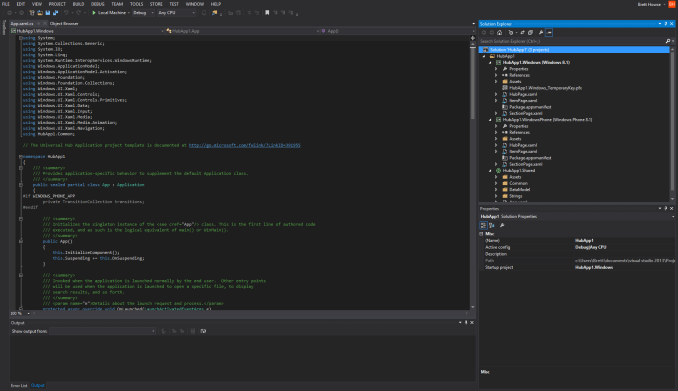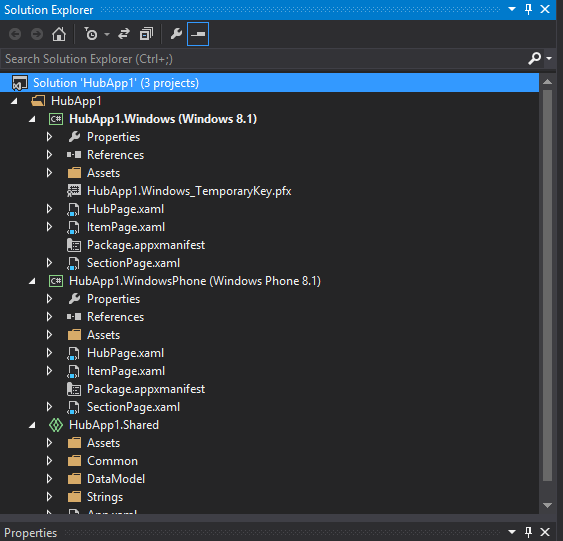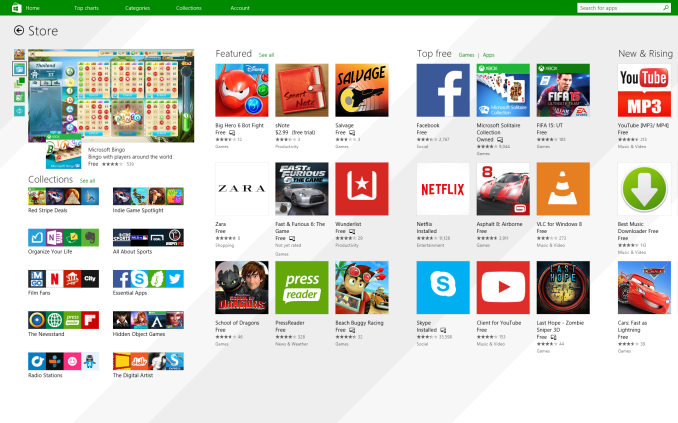Windows 10 Technical Preview First Impressions: The Return Of The Desktop
by Brett Howse on November 13, 2014 8:00 AM EST- Posted in
- Software
- Microsoft
- Windows 10
Universal Apps and the Windows Store
We just got done discussing why a single user interface for the OS across multiple devices is not always the ideal solution, so of course the obvious question with Universal Apps is why would you want it with the app model instead? Thankfully this is not the case although the term Universal App might lead people to believe they are attempting to have a single app target all of their platforms. The truth of the matter is that Universal Apps are Universal in the sense that they share a common app store.
If Microsoft is going to have Windows 10 succeed on desktops, laptops, tablets, phones, and even Xbox One, they need developer buy-in. A platform without apps is not much use to anyone. With the Universal App, they can bridge all of their platforms with a single App in the store. Under the hood, each app is created with a common framework of code, as well as multiple user interfaces in order to tailor the experience to the correct device type. Below is a screenshot of Visual Studio – Microsoft’s developer tools – with a new Universal App about to be created.
 Visual Studio Showing a Universal App Project
Visual Studio Showing a Universal App Project
As you can see, there is a shared portion of code, and then a project for the UI for Windows 8.1, and Windows Phone 8.1. Xbox One is not available yet, but should be added in a future release of Visual Studio.
A close up of the projects
But you may be wondering why any of this is necessary. Windows has the largest selection of applications of any system ever. That is of course true, and the Win32 framework has served both Windows and its users well over the years. But with the new WinRT framework there are some big advantages. First, it can be written to in multiple languages including HTML. WinRT supports C++/CX, C#, VB.NET, and HTML scripting with JavaScript and TypeScript. The security model for WinRT apps is a lot different than Win32, with all WinRT apps running in a sandbox mode for higher security. Unlike apps written in .NET, WinRT is native code, which should result in better performance. Contracts and Extensions are also new to WinRT, and allow apps to share data while still being in a sandbox. One of the biggest advantages of WinRT is that it is DPI aware, and can automatically scale apps appropriately based on screen size and screen resolution. Here, as we know, Win32 apps can struggle even though there are solutions in place.
Adobe Touch WinRT (left) vs Adobe Reader Win32 (right) on HiDPI display
One of the biggest disadvantages of WinRT is that it is only available on Windows 8 and newer devices. With Windows 8 struggling in the market as compared to Windows 7, the user reach of a developer targeting WinRT apps in the Windows Store would be for a subset of the total user base. With Windows 7 having over 50% of the desktop OS market share to itself, this is going to be an issue.
With Windows 10, Microsoft is certainly targeting Windows 7 users. If they can convince them to upgrade to the latest version of the operating system, then the new environment will have a much larger target base and will hopefully encourage developers to target the Windows Store. We have not heard of any upgrade promotions or pricing yet, but this is one of the biggest advantages Apple has had over the years. Their user base generally upgrades the OS at a much faster uptake than Windows. This allows developers to utilize newer APIs in the latest versions of their operating systems and keep the platform progressing. Microsoft has already had to deal with people being stuck on Windows XP, and they must be wanting to avoid that with Windows 7.
Since we are discussing Universal Apps and their advantages, one of the biggest advantages is the Windows Store. With Microsoft hosting the entire download and purchase of all WinRT apps, having user settings and apps sync from one device to another is much easier. One of the greatest experiences with Windows 8.1 is signing into a new PC for the first time. When you log in with your Microsoft Account, the system asks you if you would like to copy the devices and apps from one of your other devices, or if you want to start with a clean machine. If you choose a previous machine, all of the settings, wallpaper, Start Screen layout, and Windows Store apps are synced to the new device. In the case of Windows Store apps, the app itself is listed on your Start Screen, but it is not downloaded until the first time you select it. This avoids a situation where you will significantly delay the initial login time with a massive download, as well as avoid filling the available storage with apps you may not need on that particular device.
Also, like modern tablet and smartphone OSes, WinRT apps from the store are automatically kept up to date by the store. This avoids a lot of the issues with viruses and malware attacking an older version of a product since in theory it will not be around any longer.
The one thing missing from this are the older Win32 apps on the desktop, because they are not available in the Windows Store. Prior to Windows 10, desktop apps could be listed in the store, but the store would then link to the developer’s website to allow you to purchase and install the app. With Windows 10, rumors are that desktop apps will also be available and managed through the Windows Store. Assuming this does happen, then this will be a major boon to users. Desktop apps should in theory also be able to be kept up to date using the Windows Store which should cut back on the number of outdated pieces of software targeted by malware.
The Windows Store is a key piece of Windows 10. Universal Apps can be made available for multiple platforms through the store, and, if the rumors are true, even desktop apps will be available through the store. This should make the Out Of Box Experience (OOBE) very good for users with a Microsoft Account. The WinRT framework has not yet had the killer app written for it, so hopefully with Windows 10 the framework will be expanded to allow for more powerful apps to be created.













198 Comments
View All Comments
inighthawki - Friday, November 14, 2014 - link
I have to disagree. The trend clearly began as a way to improve load times on low and limited bandwidth connections by removing a lot of the glam and gloss and relying more on CSS style sheets to expose a minimalist design. The problem is that this turned into a really awful fad of "Me too!" design philosophies and now everyone is trying to fit it in everywhere, just because it worked out in its original incarnation. Flat design works EXTREMELY well, in select cases. An operating system can have multiple uses. On a phone and a tablet, these goals are content consumption - e.g. web browsing, photos, videos, etc. On a desktop, an OS is more of a tool for productivity purposes. Flat design does NOT work well here. It may satisfy some hipster craze for their OS to look "modern" and that might be fine as they use their computers to go browse facebook and post to twitter. But this design is extremely counter productive for power users, since it strips all of the design cues that are there to empower the user, such as high contrasting window borders. skeumorphism design mimics real-world designs for a reason. The real world is an extremely productive environment that humans are familiar with. Giving humans tools in an environment that is recognizable enhances productivity. Having a window frame that appears to be made of real-world materials such as wood, glass, etc, with 3D effects that mimic depth work way better than solid colors with light accents for multitasking.I'm fine with metro on my phone and on my tablet. But on the desktop - it needs to die. This goes not just for windows, but for Office and Visual Studio as well. All the latest versions of each are easily the worst versions Microsoft has ever released.
sphigel - Thursday, November 13, 2014 - link
I used to think the same thing. When I upgraded to Windows 8 and Office 2013 I really hated the look of it. After using it a while, I now think that Windows 7 and Office 2010 are ugly looking. Having said that, I'm really looking forward to the drop shadows on windows coming back in Windows 10. They did go a little too flat with the UI in Windows 8.kmmatney - Thursday, November 13, 2014 - link
I have teh opposite reaction. I use win 8 at work and for my home computer, but also have a few Windows 7 computers at home. Whenever I go on a Windows 7 computer, the first thing that jumps out at me is how much nicer it looks compared to Windows 8.steven75 - Friday, November 14, 2014 - link
Same experience. I also have used Office 2013 for a while, and even in the farsical "dark theme" that is a very very lightly shaded gray, I still HATE the white-everywhere with no contrast look of it.GuardianAngel470 - Saturday, November 15, 2014 - link
I've been using Office 2013 for a while now. I like it, but then I've never really used Office with a Dark theme so, even though "Dark" is light grey, it doesn't really bother me.However, for anyone who does use Dark for anything, I sympathize completely.
andrewaggb - Sunday, November 16, 2014 - link
Yeah the windows 8 color scheme has grown on me as well. Not a big fan of IOS 8's theme.I don't use the start screen at all on the desktop, but I love it on my miix tablet. Definitely was a mistake to try to force it on the desktop, but I think everyone except microsoft knew that. And probably many people there did as well.
jabber - Friday, November 14, 2014 - link
For me what was wrong for Windows 8 was the use of purple on the desktop in so much of the media advertising. Looks wrong.Who likes Purple? Notice that Windows 10 now uses far more neutral blue.
Da W - Thursday, November 13, 2014 - link
9.0/10 for Windows 10 so far.The thing i miss i that i don't clik the start button to see some of my live tiles as often now. Some tiles (facebook, mail, calendar, weater) are useful. They should make them like widget on your desktop (yes bring back the widgets).
Houdani - Thursday, November 13, 2014 - link
Rather than widgets, I'd be happy if they would let us snap a "start screen" to one side of the monitor so we could fill it with a selection of live tiles.croc - Friday, November 14, 2014 - link
"That is what is going to make or break this version for mainstream users (who by in large like win8.1)" I'd have a hard time calling 11% 'mainstream'.http://www.netmarketshare.com/operating-system-mar...